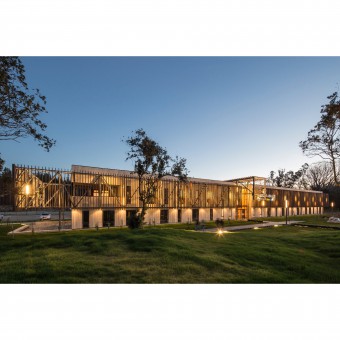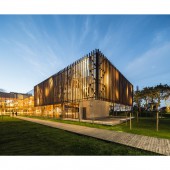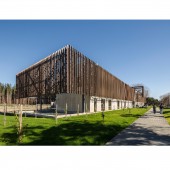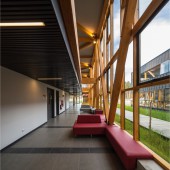Woodbox Learning Enviroment Learning and education Enviroment by Alvaro Velasquez and Mauricio Nachmann |
Home > Winners > #56525 |
 |
|
||||
| DESIGN DETAILS | |||||
| DESIGN NAME: Woodbox Learning Enviroment PRIMARY FUNCTION: Learning and education Enviroment INSPIRATION: The College campus try to engage all the community with the Wood Industry process providing a unique Learning environment. The Design solution summarize the technology and process behind creating architecture from a Pine wood forest to a wide variety of construction and design solutions. UNIQUE PROPERTIES / PROJECT DESCRIPTION: The college Building house classrooms, workshops, cafeteria, librar, chapell and admin areas in a 30.000 sf of state of the art wood building. The design team was commissioned to design a Technical College building plus construction in 12 month. To achieve such a challenge, the design team work closely with Celulosa Arauco wood manufacture developing a comprehensive prefabricate system that include Glulam beams, floor and wall panels, curtain wall systems and a rain screen facade. OPERATION / FLOW / INTERACTION: The building himself has been designed as a learning tool. It shows to students and educators how a tree became a sophisticate and high end learning environment. Common interior and exterior spaces provide the appropriate framework for interaction, discussion and innovation. The whole campus engage the student community with the forest and surroundings. PROJECT DURATION AND LOCATION: The project design started in Santiago Chile July 2015 ending construction in the south of Chile Arauco region April 2016. The design has been showcase in several magazines and on line web pages. FITS BEST INTO CATEGORY: Architecture, Building and Structure Design |
PRODUCTION / REALIZATION TECHNOLOGY: Wood in several products. Glulam Beam, wood columns, Wood Wall Panels, Wood Veneer panels, glass and Glulam courtin wall system, CLT panels (stairs), Floor Tile and carpet. Every structural component was fabricated using large scale plotter/cutting machine, all the connectors and joint pieces where fabricate in the same way. SPECIFICATIONS / TECHNICAL PROPERTIES: 30.000 sf. Administrative offices, library and media center, technical workshops, classrooms, chapel, cafeteria, lobby and common areas for gathering and learning interaction. Exterior wood pathway systems. A 85 mts by 12 mts and 8 mts high wood box. Column and beam structural system with wall panels and slabs. Acoya treatment to preserve natural wood on exterior facade panels. High Performance strategy that use natural airflow from glass corridor to classrooms in summer and heat stack for winter. TAGS: education, wood, design, college, higher education, learning enviroment RESEARCH ABSTRACT: We consider the Architectural challenge a research journey himself. As designers and planners, we play a critical role in synthesizing both knowledge and experience, integrating diverse ideas and perspectives towards the common goal. GDN had the opportunity to further explore these principles during a recent project in Chile, dual sponsored by Celulosa Arauco Wood Company and DuocUC. The challenge was to create an educational facility that held the purpose of general higher education during the daytime, with corporate education and development as focus on off hours. The type of subjects could range from computer technology to the exploration of wood products and the structuring of industry implementation. In the initial discovery we set forth by learning about the unique qualities and characteristics of the project and its benefactors. DuocUC is a well-known and respected technical college that has successfully provided a high level of education to the public sector through establishing programs focused on the necessary technical industries that support and service their communities. Celulosa Arauco maintains their high standards and focus on providing innovative and sustainable ways in addressing the forestry industry, its products, harvesting materials, distribution, and its global impact. The design process based itself on multi-levels of participation, and integrated a diverse range of stakeholders from the region, helping to define local needs, blending business aspects and strategies, setting up specific program expectations and innovative practices, and included welcoming the native “Mapuches,” who brought a deep understanding and perspective of the cultural respect and value for the areas history, as well as the sacred visions towards the environment and local protected species. Each design decision from that point forward, based itself upon guiding principals that were gathered through this expanded participation, and tested for their educational value and impact. The setting was chosen in a remote region in southern Chile, outside of Concepcion, in the heart of the forestry business for Arauco. As DuocUC was looking to expand their presence in this region, so was Arauco looking to better serve its community, which lacked the contemporary infrastructure and physical resources to better educate and develop their employees. It became important for the design to emphasize the industry’s practices and profile, using flexible systems that would allow fast manufacturing and simplicity of assembly. Installation of each component needed to be obvious in the design, and a “wood box” symbolism became the guide for the elements, housing the classrooms, workshops, and academic support functions. In contrast, a grounded, zinc-clad element was created to offset the open wood volume and house a chapel, library, and administration and cafeteria functions. It was critical for the design to respect how the facility and its pieces would align gently within the pine-grove site, but even further, how these pieces would showcase themselves through craft and detail, where each element became part of the story and memory of Arauco and its partners. High performance strategies and sensitivities added to the overall care of the project, and provided a solution that expressed the local culture, while empowering growth and development of its diverse community. CHALLENGE: The main challenge by far was the time and resources. The nature of education market require to have the new college building ready to go by March 2016. Thats mean only 10 month for Design and construction of 30.000 sf facility. It was also mandatory to use and apply wood materials and it associate technology extensively trough the proyect. During the Design process, we found two cultural challenges related to a local native community "Mapuches" ADDED DATE: 2017-03-06 18:31:23 TEAM MEMBERS (8) : PIC, Senior Architect Designer: Alvaro Velasquez, Senior Project Architect: Mauricio Nachmann, Architect Designer: Fernanda Bousquets, BIM Architect: Bruno Coulon, Landscape Architects: Teresa Mollar & Macarena Urzua, High Performance: Lucas Vasquez, and IMAGE CREDITS: Aryeh Korenfeld & GDN Architects PATENTS/COPYRIGHTS: Non applicabile |
||||
| Visit the following page to learn more: http://www.global-dn.com | |||||
| AWARD DETAILS | |
 |
Woodbox Learning Enviroment Learning and Education Enviroment by Alvaro Velasquez and Mauricio Nachmann is Winner in Architecture, Building and Structure Design Category, 2016 - 2017.· Read the interview with designer Alvaro Velasquez and Mauricio Nachmann for design Woodbox Learning Enviroment here.· Press Members: Login or Register to request an exclusive interview with Alvaro Velasquez and Mauricio Nachmann. · Click here to register inorder to view the profile and other works by Alvaro Velasquez and Mauricio Nachmann. |
| SOCIAL |
| + Add to Likes / Favorites | Send to My Email | Comment | Testimonials | View Press-Release | Press Kit |
Did you like Alvaro Velasquez and Mauricio Nachmann's Architecture Design?
You will most likely enjoy other award winning architecture design as well.
Click here to view more Award Winning Architecture Design.








